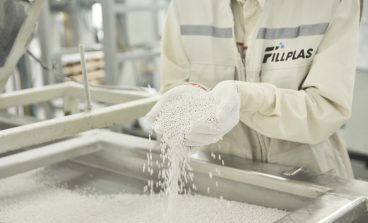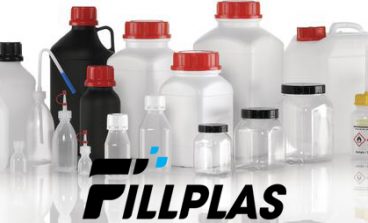
Polyethylene (PE) is the most common plastic. It is used widely in plastic packaging. As a reference to relation with CaCO3 filler masterbatch, we could have some studies in this polymer.
1. PE properties
Polyethylene has different properties of mechanical, chemical, electrical, optical, and thermal.
As mechanical properties, PE is of low strength, hardness, and rigidity, but has high ductility and impact strength as well as low friction.
As thermal properties, the melting point of PE is normally in the range of 120 to 180 °C (248 to 356 °F) for medium and high-density polyethylene; and the average melting point of 105 to 115 °C (221 to 239 °F) for low-density polyethylene. The temperatures have a big difference between the types of PE.
As chemical properties, most grades of PE types are resistant; PE is possible to dissolve at elevated temperatures in some solvents; polyethylene absorbs almost no water.
As electrical properties, PE is a good electrical insulator.
As optical properties, PE can see in clear (transparent), milky-opaque or opaque, depending on thermal properties and film thickness.
2. PE classification
There are more than 10 types of polyethylene. However, in regard to sold volumes, the most important and popular polyethylene grades are HDPE, LLDPE, and LDPE.
Grade of PE – High-density polyethylene (HDPE)
Definition: HDPE is a density of greater or equal to 0.941 g/cm3. HDPE has a low degree of branching and thus stronger intermolecular forces and tensile strength. Ziegler-Natta or metallocene catalysts can produce HDPE. The lack of branching is ensured by an appropriate choice of catalyst.
Properties: flexible, translucent, weatherproof, good low-temperature toughness (to -60’C), easy to process by most methods, low cost, good chemical resistance.
| HDPE Physical Properties | Value |
| Tensile Strength | 0.20 – 0.40 N/mm2 |
| Notched Impact Strength | no break |
| Thermal Coefficient of Expansion | 100 – 220 x 10-6 |
| Max. Continued Use Temperature | 65 oC (149 oF) |
| Melting Point | 126 oC (259 oF) |
| Density | 0.941 – 0.965 g/cm3 |
Grade of PE – Low-Density Polyethylene (LDPE)
Definition: LDPE is a density range of 0.910 – 0.940 g/cm3. It has a high degree of short and long-chain branching. Free radical polymerization creates LDPE. The high degree of branches with long chains gives molten LDPE unique and desirable flow properties.
Properties: semi-rigid, translucent, very tough, weatherproof, good chemical resistance, low water absorption, easily processed, low cost.
| LDPE Physical Properties | Value |
| Tensile Strength | 0.20 – 0.40 N/mm2 |
| Notched Impact Strength | no break |
| Thermal Coefficient of Expansion | 100 – 220 x 10-6 |
| Max. Continued Use Temperature | 65 oC (149 oF) |
| Melting Point | 110 oC (230 oF) |
| Glass Transition Temperature | -125 oC (-193 oF) |
| Density | 0.910 – 0.940 g/cm3 |
Grade of PE – Linear-Low Density Polyethylene (LLDPE)
Definition: LLDPE is a density range of 0.915 – 0.925 g/cm3. It is a substantially linear polymer, with significant numbers of short branches, commonly made by copolymerization of ethylene with short-chain alpha-olefins.
Properties: The physical properties of LLDPE depend on its molecular weight (MW) and density (0.916–0.940 g/cm3). LLDPE has improved mechanical properties, compared to LDPE at the same density since the increased regularity of the structure and narrower molecular weight distribution. The greater stiffness results in an increase of 10 to 15°C in the melting point of LLDPE compared to LDPE. LLDPE has higher tensile strength, puncture resistance, tear properties, and elongation than LDPE. However, LDPE has better clarity and gloss than LLDPE. LDPE also has better heat seal properties.
3. PE application
LLDPE has penetrated almost all traditional markets for polyethylene. Typical uses for LLDPE include stretch (cling) film, grocery sacks, and heavy-duty shipping sacks.
LDPE uses in manufacturing various containers, dispensing bottles, wash bottles, tubing, plastic parts for computer components, and various molded laboratory equipment. Its most common use is in plastic bags. LDPE includes containers and bags for food and clothing, industrial liners, vapor barriers, agricultural films, household products, and shrink and stretch wrap films.
There are many types of products in HDPE plastic:
- Containers for milk, detergent, bleach, juice, shampoo, water, and industrial chemical drums made by extrusion blow molding;
- Buckets, thin-walled dairy containers, and closures made by injection molding;
- Cosmetic containers, pharmaceutical bottles, and deodorant containers made by injection blow molding;
- And blown and cast films utilized in flexible packaging applications such as cereal, cracker and snack food packaging, wraps for delicatessen products, and grocery sacks.
4. Relation of CaCO3 filler masterbatch and LLDPE, LDPE, HDPE
LLDPE, LDPE, HDPE are widely used in the plastic industry, also CaCO3 filler masterbatch.
CaCO3 filler masterbatch is a material mixed of CaCO3 and different carrier resins, including LLDPE, LDPE, HDPE. And, CaCO3 filler masterbatch is used to replace some percentage of resin to mix with the other resins, popular plastic of LLDPE, LDPE, and HDPE, to produce plastic products.
Fillplas is a manufacturer and exporter of CaCO3 filler masterbatch with using the above carrier resins.



